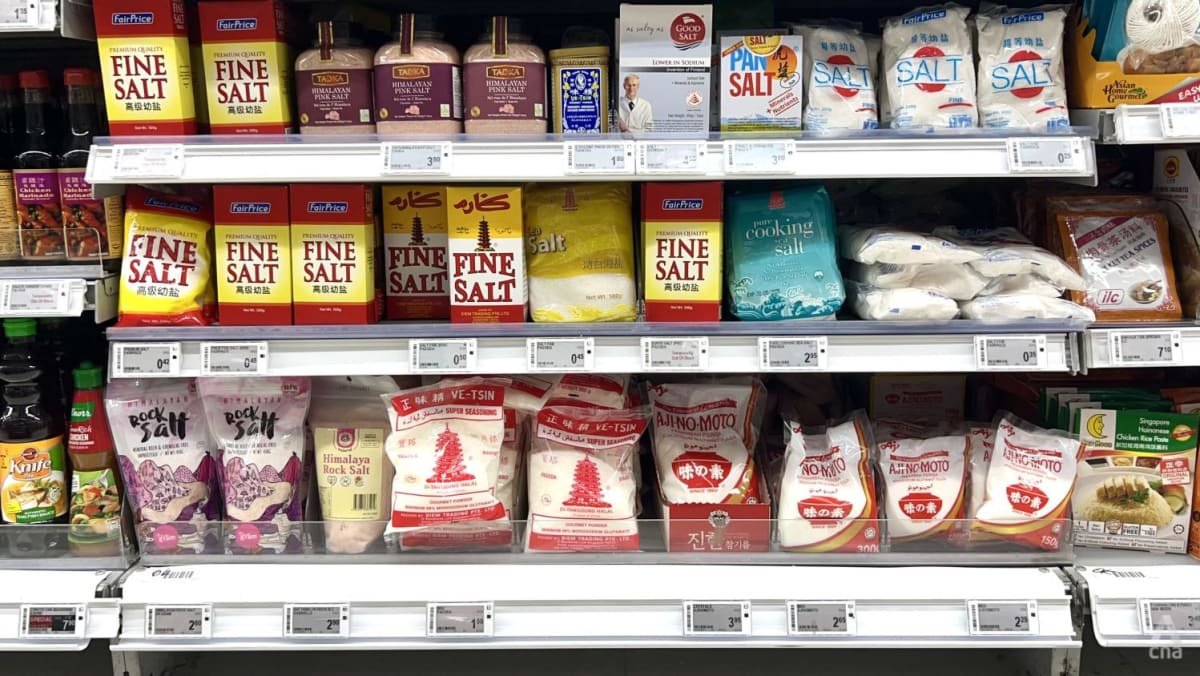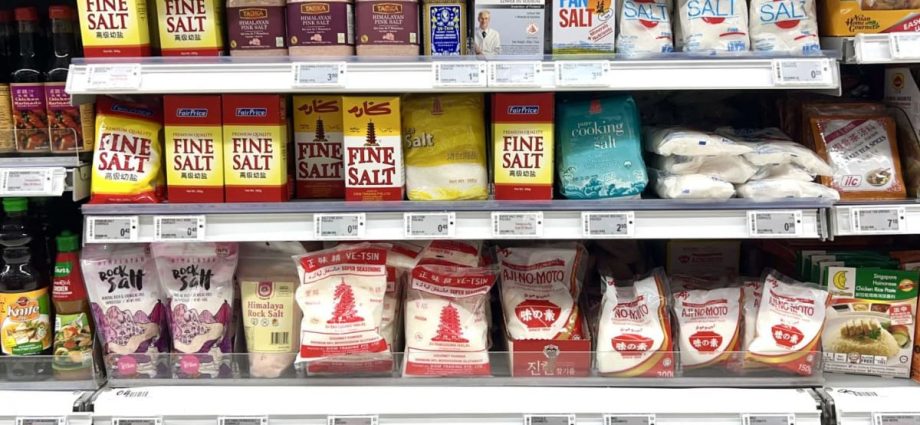
What about other natural salts? Are they also healthier?
Some shoppers may opt for popular natural salts like Himalayan pink salt, kosher salt or sea salt, thinking that there are health benefits.
In reality, these salts do not offer any significant nutritional benefits compared to table salt even though they are more expensive, said Dr Bhaskaran, who is also the president of the Singapore Nutrition and Dietetics Association.
Himalayan pink salt contains more potassium compared to table salt. Kosher salt is similar to table salt and does not contain any trace minerals, iodine or anticaking agents, she added.
“But there is no significant difference in the sodium content between these varieties,” said Dr Bhaskaran.
Natural salts are different from regular salt mainly in their texture and the way they are processed, said Ms Stephen.
Regular salts are typically granulated, refined to remove other minerals and sometimes iodised. Natural salts are “processed minimally”, leaving most of the trace materials such as magnesium, potassium and calcium intact, she added.
“However, the presence of these minerals are so minute and do not add much nutritional value,” said Ms Stephen.
“It is better to obtain these minerals from other healthy foods for more tangible health benefits.”
Both natural and regular salts contain the same amount of sodium – about 40 per cent, which yields about 2,000mg of sodium per teaspoon.
This means that both have the same potential to impact blood pressure and cause cardiovascular diseases, Ms Stephen said.
What about MSG? Isn’t it bad for me?
For years, MSG has been viewed as unhealthy as a small percentage of the population reported that they had symptoms like headaches and increased thirst after consuming food at Chinese restaurants, said Dr Bhaskharan.
However, newer research has questioned the accuracy of its supposed adverse effects on health, she said.
MSG, or monosodium glutamate, is a flavour enhancer derived from L-glutamic acid, which is naturally found in foods like tomatoes, mushrooms and onions, nutritionists said.
It also can be artificially made via fermentation using corn or sugar beets.
MSG is a non-essential amino acid, which means that our body can produce it and doesn’t need to get it from food, said Dr Bhaskharan.
It contains about 12 per cent sodium, which is lower than regular salt.
Even though it has less sodium, it can enhance salt perception, and the flavour of food by adding umami, which is a taste that helps to intensify the meaty, savoury flavour, said Ms Stephen.
This means that just a small amount is needed to elevate the overall flavour of healthier foods with lower sodium content, she added.
Research has also shown that MSG can be used as a suitable replacement for some salt in packaged foods like snacks and soups, which can help to reduce their sodium content by 30 to 50 per cent.
“This provides good potential to use MSG to formulate healthier, ‘better-for-you’ food products without compromising on taste. This in turn can propel consumers to choose more nutritious food options and positively impact health,” Ms Stephen said.
If I use less salt or switch to lower-sodium alternatives, how can I still make sure my food is tasty?
It is feasible to replace regular salt with lower-sodium salt, and reduce sodium intake significantly without compromising taste, said Dr Bhaskaran.
“This ‘stealth’ approach of salt substitution has no significant impact to taste and is recognised as arguably the best current strategy to reduce sodium intake and blood pressure at the population level,” she added.
Studies have shown that after consuming a diet with a 30 to 50 per cent overall reduction in sodium content for two to three months, people gradually developed a preference for foods with lower salt level, said Dr Bhaskaran.
“It is a matter of time to accept the lower salt taste compared to what they have been consuming earlier.”
It is possible to gradually adjust your palate to lower-salt foods, said Ms Stephen.
It takes two to three weeks for taste receptors in the tongue to become more sensitive to salt and get accustomed to less salty food without perceiving it as bland, she added.
In cooking, fresh herbs and spices, citrus, mustard and vinegar can be used to enhance flavour. Onion, garlic, ginger and spices like turmeric, pepper and chilli can also accentuate the taste and aroma to make food more enjoyable without the need for more salt, said Ms Stephen.
Salt-free ingredients with distinctive flavour profiles also help to add unique flavours to the dish. These include mushrooms, kelp, sesame oil, bonito flakes and nutritional yeast, she added.
When shopping for ingredients, nutritionists urged home chefs to shop for healthier alternatives and go fresh as much as possible.
Foods like fresh poultry, meat and fish contain negligible amounts of sodium, and fresh fruits and vegetables contain potassium, which can help maintain lower blood pressure and better heart health.
When buying processed foods like canned food, smoked or pickled food, instant products and convenience meals, as well as sauces and condiments, choose the healthier versions, said Ms Stephen.
For example, look out for the Healthier Choice symbol, or opt for the “low in sodium” or “reduced sodium” options.
Reading nutrition labels can help one to make clearer choices when comparing food products based on their sodium content, she added.
You can also avoid sodium when eating out. For instance, you can ask for less gravy or less salt and sauces when you order items like fried rice, stir-fried vegetables or pasta, said Dr Bhaskharan.
Those who are looking to cut down on sodium should also avoid adding extra sauces or salt at the table. They can also choose fresh ingredients when ordering dishes like yong tau foo or mala xiang guo.

